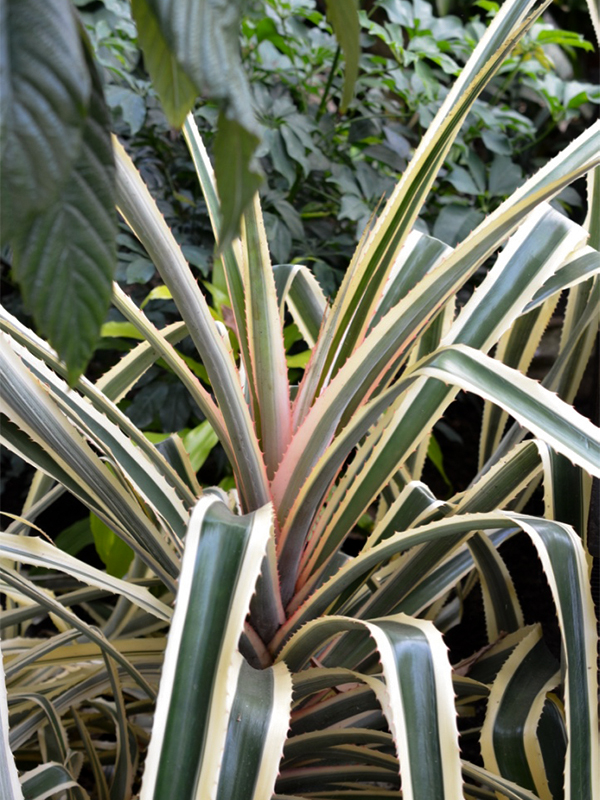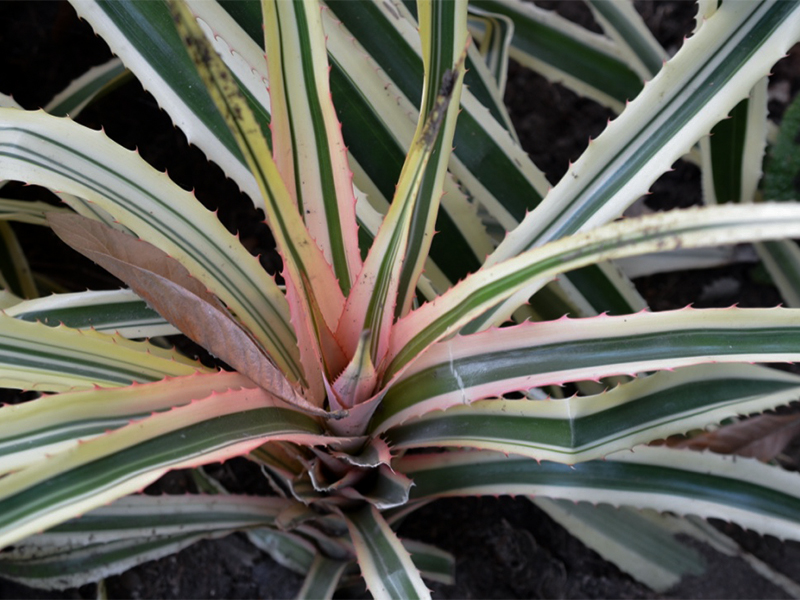
Perennials, Tropicals > Ananas > Ananas bracteatus > Ananas bracteatus 'Tricolor'
Ananas bracteatus
'Tricolor'
Red Pineapple, Wild Pineapple
Origin: Argentina, Brazil, Ecuador, and Paraguay for the species.
| Family |
| Bromeliaceae |
| Genus |
| Ananas |
| Species |
| bracteatus |
| Cultivar |
| 'Tricolor' |
| Category |
| Perennials, Tropicals |
| Synonyms |
| Ananas bracteatus, Ananas bracteatus var. typicus, Ananas comosus var. bracteatus, Ananassa bracteata, Ananas sativus var. bracteatus, Ananas bracteatus var. albus, Ananas comosus var. albus, Ananas bracteatus var. rudis, Ananas comosus var. rudis, Ananas |
| USDA Hardiness Zone |
| 11 - 12 |
| Canadian Hardiness Zone |
| Requires cold season protection under glass. |
| RHS Hardiness Zone |
| H1 |
| Temperature (°C) |
| 5 - 15 |
| Temperature (°F) |
| 41 - 59 |
Photographs
Description and Growing Information
Flowering Period
| General Description |
| Short lived, ornamental plant that is related to the pineapple. Some taxonomists classify it as a variety of pineapple instead of a separate plant. |
| Cultivation |
| Will grow in full sun to full shade with well-drained, aerated soil. Allow plant to be dry between waterings and lessen watering in winter. Fertilize mildly every 4 weeks. |
| Growth |
| Slow |
| Pests |
| Scale, thrips, and mealybugs. |
| Habitat |
| Up to 500 m above sea level, in deciduous or semi-deciduous tropical forests for the species. |
| Bark/Stem Description |
| Almost acaulescent or with a very short, trunk-like stem at the base of the rosette. |
| Leaf Description |
| Many arching leaves, arranged in a spiral in a spreading rosette, that are simple, ribbon-like, fibrous, with sharp spines that curve up toward the leaf tips. |
| Flower Description |
| Floralscape grows up to 50 cm long, robust and straight, develops at the centre of the rosette and ends with an inflorescence. Flowers and fruits will remain all summer and rot away by late autumn. |
| Fruit Description |
| This plant will only produce one fruit over its life (monocarpic). The fruit is a small to medium and syncarp. The ripe fruit is palatable, but it is smaller, usually full of seeds, fibrous, lacking in juice and less fleshy than commercial pineapples. |
| Colour Description |
| Leaves are dark green, pale yellow, with a tinge of red along the edges. Flowers are purple to reddish pink. Fruit has brownish pink to scarlet skin and flesh is pink to yellow. |
| Texture Description |
| Fruit skin is tough and waxy. |
| Notable Specimens |
| Centennial Conservatory, Thunder Bay, Ontario, Canada. |
| Propagation |
| Remove and replant offshoots of the mother plant. |
| Ethnobotanical Uses (Disclaimer) |
| The edges of the leaves have fine teeth so use extreme caution when handling. Fruit if produced is edible. |

